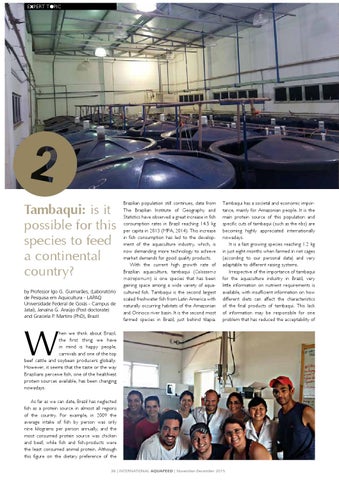EXPERT T●PIC
2 Tambaqui: is it possible for this species to feed a continental country? by Professor Igo G. Guimarães, (Laboratório de Pesquisa em Aquicultura - LAPAQ Universidade Federal de Goiás - Campus de Jataí), Janaína G. Araújo (Post doctorate) and Graciela P. Martins (PhD), Brazil
Brazilian population still continues, data from The Brazilian Institute of Geography and Statistics have observed a great increase in fish consumption rates in Brazil reaching 14.5 kg per capita in 2013 (MPA, 2014). This increase in fish consumption has led to the development of the aquaculture industry, which, is now demanding more technology to achieve market demands for good quality products. With the current high growth rate of Brazilian aquaculture, tambaqui (Colossoma macropomum) is one species that has been gaining space among a wide variety of aquacultured fish. Tambaqui is the second largest scaled freshwater fish from Latin America with naturally occurring habitats of the Amazonian and Orinoco river basin. It is the second most farmed species in Brazil, just behind tilapia.
Tambaqui has a societal and economic importance, mainly for Amazonian people. It is the main protein source of this population and specific cuts of tambaqui (such as the ribs) are becoming highly appreciated internationally nowadays. It is a fast growing species reaching 1.2 kg in just eight months when farmed in net cages (according to our personal data) and very adaptable to different raising systems. Irrespective of the importance of tambaqui for the aquaculture industry in Brazil, very little information on nutrient requirements is available, with insufficient information on how different diets can affect the characteristics of the final products of tambaqui. This lack of information may be responsible for one problem that has reduced the acceptability of
W
hen we think about Brazil, the first thing we have in mind is happy people, carnivals and one of the top beef cattle and soybean producers globally. However, it seems that the taste or the way Brazilians perceive fish, one of the healthiest protein sources available, has been changing nowadays. As far as we can date, Brazil has neglected fish as a protein source in almost all regions of the country. For example, in 2009 the average intake of fish by person was only nine kilograms per person annually, and the most consumed protein source was chicken and beef; while fish and fish-products were the least consumed animal protein. Although this figure on the dietary preference of the 36 | INTERNATIONAL AQUAFEED | November-December 2015
